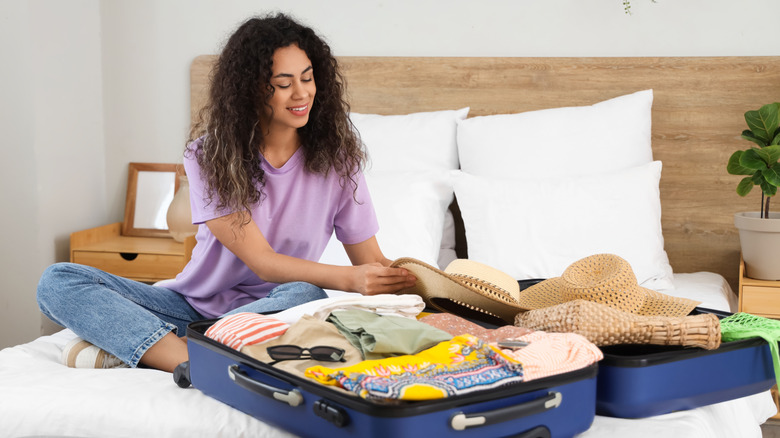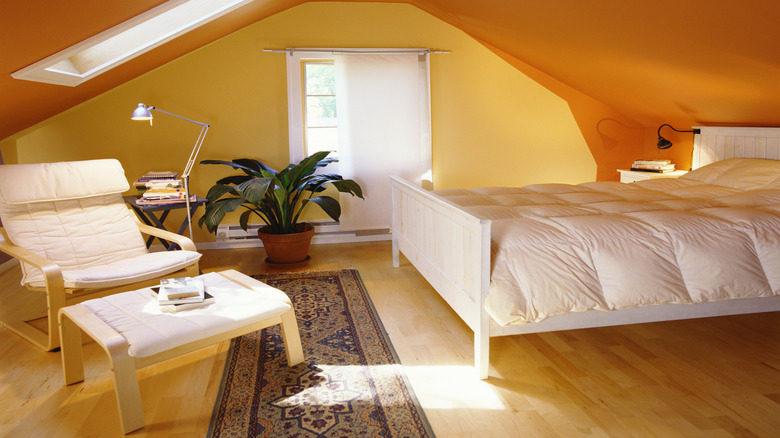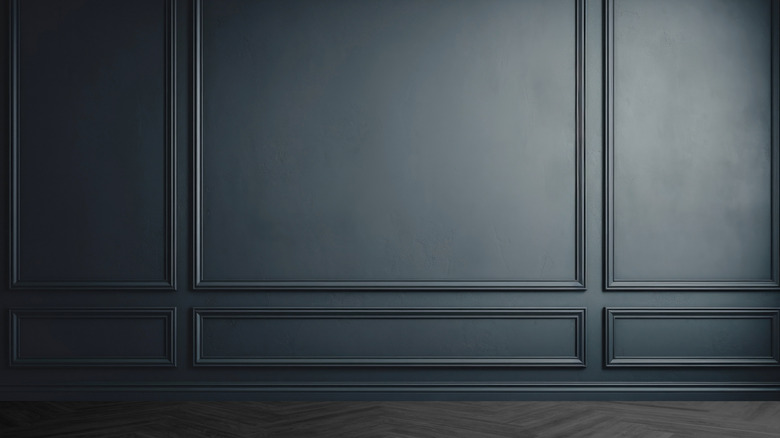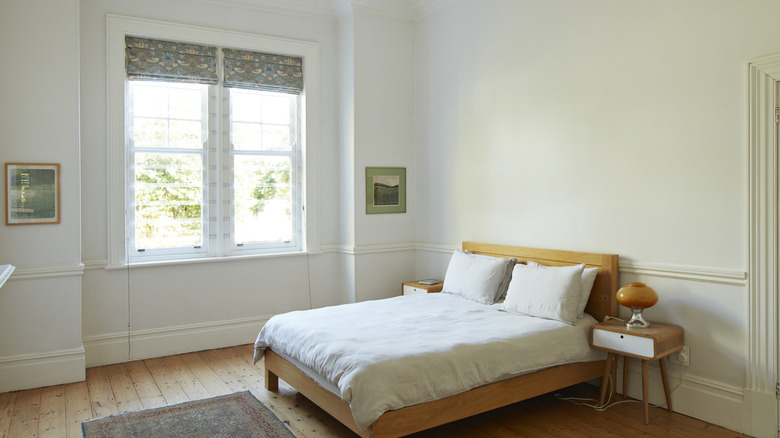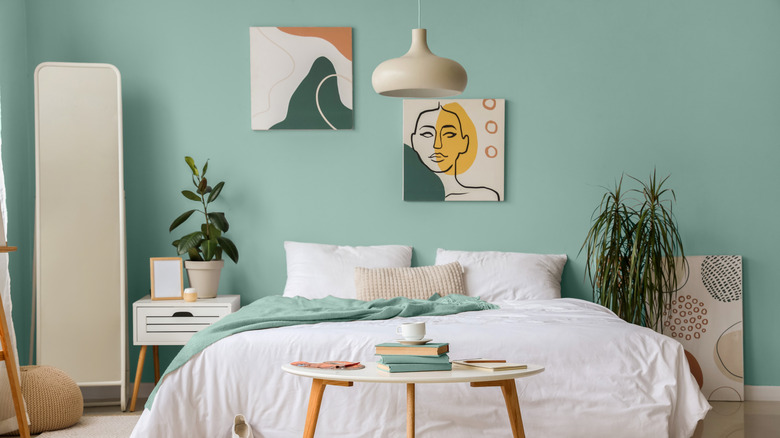3 Colors You Should Never Paint Your Guest Bedroom
If your goal is to create a guest-friendly home, your guest bedroom is a good place to start. From the furniture to the wall color, the guest room details matter when creating an inviting space for your visitors. Paint colors set the tone for the room and often influence your mood according to color psychology.
Your guest room may only get used occasionally by visitors, and it could be used for other activities, such as doubling as a home office or play room. Keeping the different uses in mind helps you make design choices, including paint colors. It might be tempting to choose bright, bold colors to make the space fun and energetic, especially since it's not used every night for sleeping. However, the ultimate goal is to create a welcoming space where guests can feel relaxed. Choosing a wall color that's calming and encourages sleep is a solid choice.
Warm colors tend to create energy and excitement in a room — not exactly the vibe you want in a room meant for rest. Cooler hues and those found in nature tend to soothe and calm people, making those shades better suited for sleeping spaces. However, some cool tones, such as dark blue, can venture into gloomy territory or create a moodiness that's not fitting for a guest suite. Understanding the feeling that different colors create helps you decide which paint options to avoid in your guest space.
Bright red, orange, and yellow are too energizing
Red, yellow, and orange fall into the warm color family and are known for generating happiness and energy. While you want your guests to feel happy when they visit, you don't want to keep them up all night with a bright, energizing wall color. The colors are often too jarring and vibrant to let your guests settle down and relax for the night.
The individual colors may have specific negative effects, starting with red, which can fuel feelings of anger when you choose bright shades. It can also increase your heart rate, blood pressure, and respiration, which makes it difficult to sleep. Orange is said to make you hungry and increase your energy levels. That extra boost is the opposite of the calming effect you want in a bedroom and is often better suited for exercise or play rooms. Yellow is often associated with sunny happiness and may spark creativity, but brighter shades could raise your blood pressure and cause anxiety, especially when it's completely coating the walls. Lighter yellow shades, however, don't trigger as much excitement and could still work in a guest room.
You don't have to skip brighter colors completely in your spare bedroom. Sprinkling red, orange, or yellow into the decor through throw pillows, blankets, wall hangings, and rugs adds a touch of happiness to the space without being too overwhelming. Choosing muted versions of the colors also helps you maintain a calmer, warmer atmosphere in the room if you want to paint the walls red, yellow, or orange.
Black creates a dark, uninviting vibe
You'll find many popular black paint colors to make a serious statement, but your guest room might not be the best place to incorporate this color trend. The dark hue can be a bit too moody for a guest room. Black can lower the energy in the room, which could help guests prepare for sleep. However, it may also cause feelings of depression or aggression that could leave a negative impression of their stay. Black may create an uninviting feeling in your guest room, and it could create a closed-in feeling if the room lacks lighting.
The idea behind using black in your decor is to create a sophisticated, elevated look. You can incorporate that into the guest room without painting the walls black. Try painting the trim or door black for a pop of the bold color. It also works for furniture pieces or decorative accents in the guest room.
If you decide to use black for all of your walls, an accent wall, or even the ceiling, keep in mind that there is a wide range of black shades available in paint. Most options have either warm or cool undertones, even if they're subtle. Brown undertones lend warmth to the black paint and work well with other warm shades or lighter neutral colors. Cooler black colors feature blue and green undertones, adding a serene quality, especially when combined with other cool hues.
Neutrals with cool undertones are often gloomy
Neutral colors like white and gray seem like safe territory for your guest room, but the undertones could ruin the color when you're trying to create a tranquil visitor-ready guest room. Cool undertones that make the paint lean toward a bluish hue could create a gloomy look in the guest room. The effect is often more noticeable on overcast days that feel drab on their own. Instead of making guests feel cozy and warm, you could leave them feeling lonely and blue.
Stark white can be both boring and overwhelming at once. It often makes the space feel too sterile, which goes against the warm, cozy feeling you want in a guest room. Intense white walls can also make the space brighter, which is fine during the day but could be too stimulating at night. If you want a light look, consider an off-white color with warmer undertones. Meanwhile, gray is often calming, but it can also drain emotion from the space and make it feel impersonal. Lighter gray colors with warm undertones often feel more inviting, earthy, and cozy than dark gray, which can be overly moody, and grays with cool undertones, which can feel too cold.
Colors you should choose for a guest room
The best colors to paint your guest room create a restful, relaxing feel without being too overwhelming or energizing. Soft blue, purple, and green colors often fit that description with their soothing effects. Light blue may even help your guests if they have insomnia due to its peaceful feeling. Avoid darker shades of blue, which could make guests feel sad. Colors that mimic the ocean are often relaxing. Other soft blue colors to consider include sky blue and cornflower blue. If you want to embrace the relaxing, calming effect of purple, stick to lavender or similar lighter shades. Its connection to nature makes green paint colors serene and balancing. However, green shades that have a yellowish look could increase anxiety levels. Try a sage green color with blue undertones, or opt for one with a brown base to keep the space earthy.
If you want a more neutral color for your guest room, look for a warm cream color with subtle yellow undertones to create a cozy atmosphere. Soft gray colors with warm undertones keep the space neutral while adding some warmth to the room. This can include gray colors that lean toward a brown or beige look, such as the popular greige.
